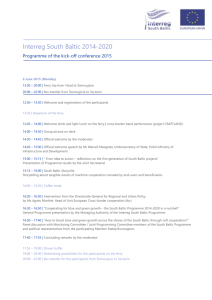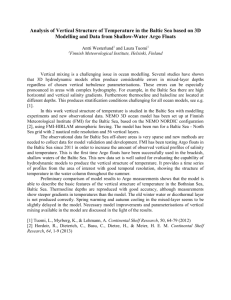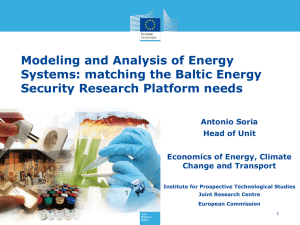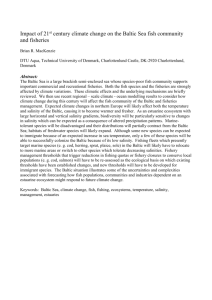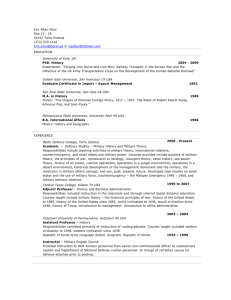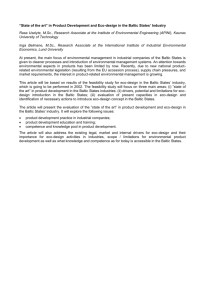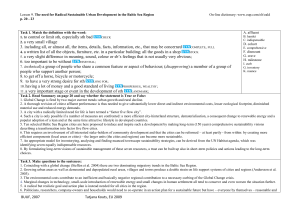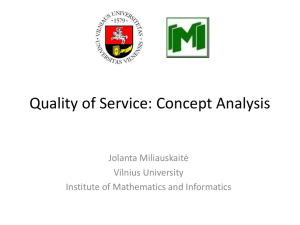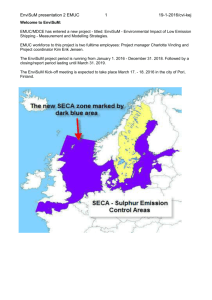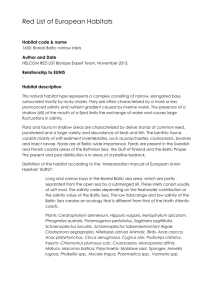Smart Specialization preparation in Lithuania and Baltic States
advertisement
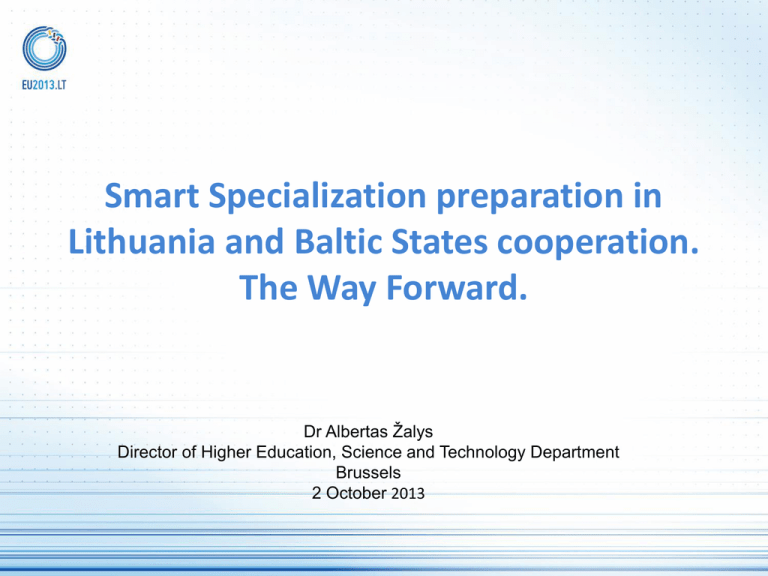
Smart Specialization preparation in Lithuania and Baltic States cooperation. The Way Forward. Dr Albertas Žalys Director of Higher Education, Science and Technology Department Brussels 2 October 2013 Why Smart Specialization? • Cohesion Funds 2007-2013 – 86 billion € for innovation IMPACT? • • • • Lack of inter-institutional coordination Regions invest in „fashionable“ areas, great overlap No critical mass Funding for R&I capacity building, lack of concentration on results • Economical crisis: a) greater orientation towards efficiency; b) need to strengthen economic competitiveness • Transformation requires resource concentration • Need to improve policy development and implementation The process First stage Second stage Development of methodology December 2012 Development of management structure January 2013 Improvement of methodology and awareness raising (constant activity) February 2013 Analysis of key challenges, trends and drivers at national and international level; Expert panels March/April 2013 Assessment of current potential in R&D and business March/April 2013 National survey; Expert panels PRIORITY FIELDS May/June 2013 KET and process analysis in the priority fields; Submission of ideas for priorities July/September 2013 Expert panels; Delphi survey RIS3 IMPLEMENTATON PROGRAMS October/November 2013 PRIORITIES PRIORITY IMPLEMENTATION PROGRAMS AND ROADMAPS Beginning of 2014 PIPELINE OF JOINT SCIENCEBUSINESS PROJECTS Results: Challenges Results: Potential of Research Results: Potential of Economy Current competitiveness and specialisation Current competitiveness and specialisation Q86*; L88* "Traditional" sectors: Present "locomotives": Modernisation and strenghtening of knowledge-driven growth potential. Technological upgrading /search for new niches Natural priorities: Strengthening of competitive advantages and the occupying of new niches Plant growing & animal husbandry; Forestry & logging; Foodstuffs, beverages & tobacco products; Chemicals; Land & water transport; Warehousing; Telecommunications; Financial services Computer, electronic & optical products; Medicinal products & pharmaceutical preparations; Computer programming, consultancy & information services; Production of base metals; Manufacture of machinery & equipment Wood and wood products; Straw products; Paper products; Manufacture of furniture; Construction Challenges: Restructuring, search for new products/markets. Textiles, apparel, leather and related products; Non-metal mineral products; Metal products (except machinery & equipment); Manufacture of other vehicles & equipment B*; I*; M69-70; K66* Sectors in transition: Shift of production factors toward hightechnologies and skilled labour Emerging / niche sectors: Radical innovation / search for new markets Fishing and aquaculture; Printing; Rubber and plastic products; Water collection, treatment & supply; Wholesale & retail trade; Air transport; Postal and courier services; Publishing Manufacture of electric equipment; Motor vehicles, trailers & semitrailers; Insurance & pension funds; Architecture & engineering; 13 research Advertising & market Potential for knowledge-driven growth The concept of priority Priority field – response to the global and national challenges by Lithuanian R&I system. Priority – new technologies or processes that have high potential to transform Lithuanian economy. What‘s new? •Entrepreneurial discovery •Concentration on results •Intersectorial / interdisciplinary approach •Identification and implementation of priorities as an inclusive process Priority fields Priority field R&D pot. Efficient energetics and sustainable environment High or prospective „Consumers“ (excl. IT) *** Saulėtekis, Santara, Santaka, Nemunas Food technologies and agroinnovation Prospective „Consumers“ * Nemunas Health, health technologies and bio-pharmacy High „Creators“ and „Consumers“ * Santara, Santaka Inclusive and learning society Prospective „Consumers“ (excl. IT) * New processes, materials and technologies for manufacturing „Creators“ and „Consumers“ * Saulėtekis, Santaka, Santara High „Consumers“ (excl. IT) *** Saulėtekis, Santaka, Santara, Marine Transportation, logistics and esystems Prospective Economy pot. Challenges Valleys ICT as a horizontal priority empowering all fields * - corresponds to the most important challenges identified by analysis; *** - corresponds to the most important challenges identified by analysis and ranked as most important by the survey Priority fields and initial subfields Priority field Subfields Planning of sustainable development of the energy sector; Efficient supply of energy; Efficient energy supply networks; Energy production and accumulation technologies and integrated solutions; Environmentally-friendly technologies. Modern agricultural technologies for sustainable use of biological resources; Food technologies and agroInnovative and conventional food technologies; innovation Foodstuffs storage and packaging technologies. Health technologies and bio-pharmacy Biotechnologies including cell and tissue technologies for medicine and pharmaceutics; Medical and pharmaceutical engineering; Public health technologies; Innovative e-solutions for medicine, e-resources and bio-banks. New result-oriented public service provision models; Inclusive and learning society New methods, processes and technologies enabling self-directed learning and transition to a new learning paradigm. New functional materials for industry; New processes, materials and Flexible automated production processes; technologies for manufacturing New product and process design technologies; New production technologies. Transportation, logistics and e-systems Development of transport infrastructure; Development and elaboration of sustainable transport systems; Smart logistic systems; Development and elaboration of efficient ICT. Efficient energetics and sustainable environment ICT as a horizontal priority empowering all fields Concept of Priority implementation logic Evaluation Policy Mix Idea Entry to the market Technical concept Measure 1 Ministry of Economy Measure N Pilot version E Prototype 2014....2020 Measure 2 Ministry of Education and Science Baltic States cooperation. Situation overview Implementing the Memorandum of Understanding • Establishment of expert group for mapping research infrastructures in the Baltic States • Establishment of the joint ministerial working group which will work as a coordinating body for exchange of information and coordination of the execution of the tasks defined in the MoU • Exchange information about state of play on smart specialization on a constant basis Baltic States cooperation. Situation overview Regular meetings: 19th Meeting of the Baltic Ministers of Education and Research, 13 June 2013, Tallinn Trilateral meeting during Informal Competitiveness Council (research part), 24 July, 2013, Vilnius Trilateral meeting of state secretaries/vice ministers to discuss smart specialization issues on 29 April in Riga; Trilateral meeting during after Competitiveness Council on 26 September in Brussels Trilateral meeting 27 September, Brussels Ministers agreed to: • “Baltic Bonus” idea to be developed (the amount and mechanism of the Bonus tbd.) • Exchange of info/coordination of the positions: – facilitate collaboration between Baltic NCPs – facilitate collaboration between Program committee members. Technical details will be developed on expert level. Future cooperation plans • Launch of data base/website for sharing information on available RI or unique laboratory equipment (foreseen in 2014); • Mapping of intellectual potential and R&D activities; • Coordination of Smart Specialization processes (ongoing); • Looking for possibilities for Baltic States cooperation in Horizon 2020, Joint programming and other European initiatives. For discussion: • Opening national research programs for Baltic States research institutions. Thank You!
